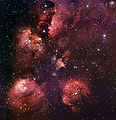NGC 6334
Appearance
| Emission nebula | |
|---|---|
 The Cat's Paw Nebula lies inside the Milky Way Galaxy and is located in the constellation Scorpius, green areas show regions where radiation from hot stars collided with large molecules and small dust grains called "polycyclic aromatic hydrocarbons" (PAHs), causing them to fluoresce (Spitzer space telescope, 2018) | |
| Observation data: J2000 epoch | |
| Right ascension | 17h 19m 58s[1] |
| Declination | −35° 57′ 47″[1] |
| Distance | 5500 ± 970 ly[2] ly |
| Apparent dimensions (V) | 40'×23' |
| Constellation | Scorpius |
| Physical characteristics | |
| Radius | 40 ly |
| Designations | ESO 392-EN 009,[1] Sharpless 8, RCW 127, Gum 64 |
NGC 6334 (also known as the Cat's Paw Nebula, Bear Claw Nebula, or Gum 64) is an emission nebula and star-forming region located in the constellation Scorpius.[3] It was discovered by astronomer John Herschel in 1837, who observed it from the Cape of Good Hope in South Africa.[4]
Gallery
-
Spitzer view of the star-forming region NGC 6334
-
This portrait of NGC 6334 was created from images taken with the Wide Field Imager instrument at the 2.2-metre MPG/ESO telescope at the La Silla Observatory in Chile.
-
Submillimetre views of the star formation region
-
Protocluster NGC 6334I is a star-forming cloud in the Cat's Paw Nebula.[6]
References
- ^ a b c "NGC 6334". SIMBAD. Centre de données astronomiques de Strasbourg. Retrieved 2007-04-10.
- ^ Russeil, D.; Zavagno, A.; Adami, C.; Anderson, L. D.; Bontemps, S.; Motte, F.; Rodon, J. A.; Schneider, N.; Ilmane, A.; Murphy, K. J. (2012). "Statistical study of OB stars in NGC 6334 and NGC 6357". Astronomy & Astrophysics. 538: A142. Bibcode:2012A&A...538A.142R. doi:10.1051/0004-6361/201117299.
- ^ Nemiroff, R.; Bonnell, J., eds. (2003-07-17). "The Cat's Paw Nebula". Astronomy Picture of the Day. NASA. Retrieved 2007-11-05.
- ^ "NGC 6334 - The Cat's Paw Nebula". SEDS Database. SEDS. Retrieved 2008-04-15.
- ^ "The Cat's Paw and Lobster Nebulae". www.eso.org. Retrieved 6 February 2017.
- ^ "Protostar blazes and reshapes its stellar nursery". www.eso.org. Retrieved 20 March 2017.
External links
Wikimedia Commons has media related to NGC 6334.
- On the Trail of a Cosmic Cat — ESO Photo Release
- NGC 6334 on WikiSky: DSS2, SDSS, GALEX, IRAS, Hydrogen α, X-Ray, Astrophoto, Sky Map, Articles and images
- Astronomy Picture of the Day - Wide Angle: The Cat's Paw Nebula 2010 April 21
- Cat's Paw Nebula at Constellation Guide


![VLT Survey Telescope image shows the Cat's Paw Nebula and the Lobster Nebula [5]](http://upload.wikimedia.org/wikipedia/commons/thumb/3/34/The_Cat%E2%80%99s_Paw_and_Lobster_Nebulae.jpg/120px-The_Cat%E2%80%99s_Paw_and_Lobster_Nebulae.jpg)



![Protocluster NGC 6334I is a star-forming cloud in the Cat's Paw Nebula.[6]](http://upload.wikimedia.org/wikipedia/commons/thumb/2/23/Protostar_blazes_and_reshapes_its_stellar_nursery.jpg/120px-Protostar_blazes_and_reshapes_its_stellar_nursery.jpg)